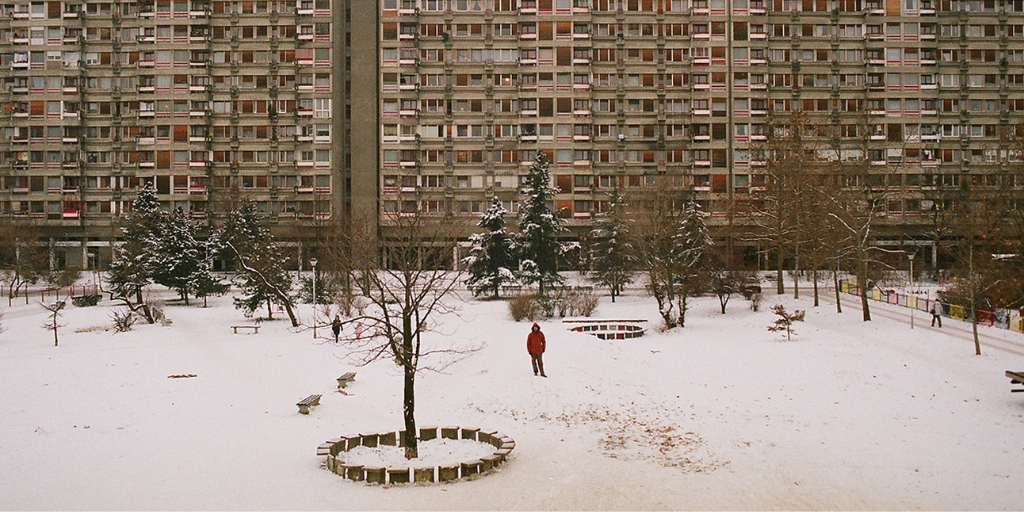Serbia’s district heating sector is facing an unprecedented crisis, driven by an overreliance on imported fossil fuels – particularly fossil gas – and an inability to control energy prices. This dependence puts the sector at a significant risk of collapse in the coming years, threatening the basic heating needs of millions of citizens. It also underscores the urgent need for the Serbian government to diversify the district heating system by integrating sustainable renewable energy sources.
Natasa Kovacevic, Heating sector decarbonisation campaigner for the Western Balkans | 1 July 2025

Photo Novi Beograd Blok 23 in December 2007, Source Flickr, CC BY-NC-SA 2.0
The sector’s financial health has been deteriorating rapidly. In 2023, for the first time, Serbia’s entire district heating sector recorded losses amounting to EUR 10 million, according to a recent analysis. The sector’s liquidity has also plummeted, with working capital deficits reaching approximately EUR 202 million (RSD 23.7 billion) – the highest shortfall in the past five years. To keep heating services operational during the 2023/2024 winter season, the sector accumulated EUR 36.4 million in additional debt, primarily due to soaring gas prices, alongside politically driven overemployment and existing investment burdens. One of the critical issues facing the sector is its unbalanced energy mix, with fossil gas accounting for 77.7 per cent of all sources. More significantly, 90 per cent is imported. In May 2022, Serbia signed a three-year gas supply agreement with Russia – at a time when the EU was actively working to reduce energy ties with the aggressor state. Serbia’s decision to deepen its dependence on Russian gas was primarily driven by a desire to stabilise energy prices.
However, recent market developments have rendered the agreement largely ineffective, despite a new annex signed in May 2025. Although the contract sets a fixed price for gas, it caps annual volumes at 2.2 billion cubic metres, forcing Serbia to turn to the more expensive open market once the limit is exceeded. Additional imports from Azerbaijan, covering 15 to 18 per cent of annual consumption, have also proven more costly.
Complicating matters, the oil-indexed pricing formula and regulatory rules set by the Energy Agency of the Republic of Serbia (AERS) have led to a price surge for market participants. Between October 2024 and March 2025, gas prices for district heating systems rose by 26.5 per cent. This significant increase has placed a heavy burden on public utility companies, driving up operational costs and threatening the financial viability of an already vulnerable sector.
Stalled reforms
Serbia’s district heating sector is now entering a critical phase. By the end of 2023, 12 companies reported losses exceeding their equity, while 18 assumed liabilities surpassing their total capital – clear indicators of deep financial instability. With heavy reliance on imported fossil fuels leaving them exposed to global price fluctuations, district heating companies are unable to prioritise new technologies and decarbonisation projects without first undergoing economic consolidation and sectoral restructuring. Until then, long-term viability remains a pipe dream.
Despite this mounting urgency, the Serbian government has yet to come up with a credible, long-term restructuring plan, as acknowledged during the 23rd Summit of District Heating Associations in June 2025. This policy vacuum continues to stall essential reforms and leaves utilities focused on short-term survival rather than on long-term modernisation.
Coordinated efforts urgently needed
At the summit, Serbia’s deputy energy minister confirmed the government had no contingency strategy for the sector, aside from limited energy efficiency measures under a public project supported by the state and the European Bank for Reconstruction and Development (EBRD). The project applies an energy service company (ESCO) model to support multi-family residential buildings, but it offers little to address the wider crisis facing many of the country’s district heating utilities. Unless the government swiftly changes course, they could shut down within less than five years. A shift towards renewable energy sources is clearly essential – not only to reduce Serbia’s exposure to the volatile fossil-gas market but also to restore financial and operational stability. To achieve this, the government must overhaul its fuel mix by prioritising sustainable local power sources such as wind and solar to secure the nation’s energy future. In parallel, the introduction of carbon pricing and a structured phase-out of fossil-fuel imports are required to support this transition and make it more affordable over the long term.
Deploying technologies such as geothermal, solar thermal, and heat pumps would diversify the current system to a considerable extent, providing secure heating and a reliable pathway for phasing out fossil gas by 2050. But without a clear national roadmap, institutional backing, and targeted investments in renewables, Serbia has no chance of meeting its energy transition goals – leaving its citizens exposed to the rising costs of an outdated heating system.
International financial institutions like KfW and the EBRD can play a key role in supporting the Serbian government to develop and implement more bankable, technically sound projects based on these sustainable renewable technologies. Their involvement must provide the credibility, financing models, and technical expertise needed to finally move from strategy to execution.
Never miss an update
We expose the risks of international public finance and bring critical updates from the ground – straight to your inbox.
Theme: District heating | Fossil gas
Project: District heating | Fossil gas
Tags: district heating | fossil gas
